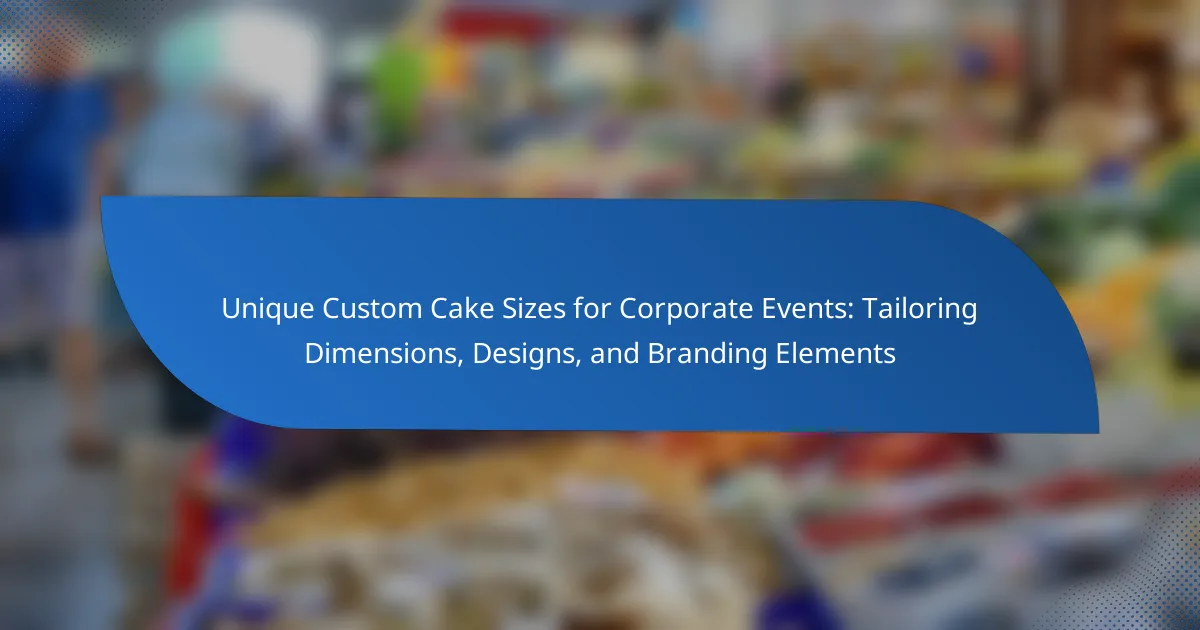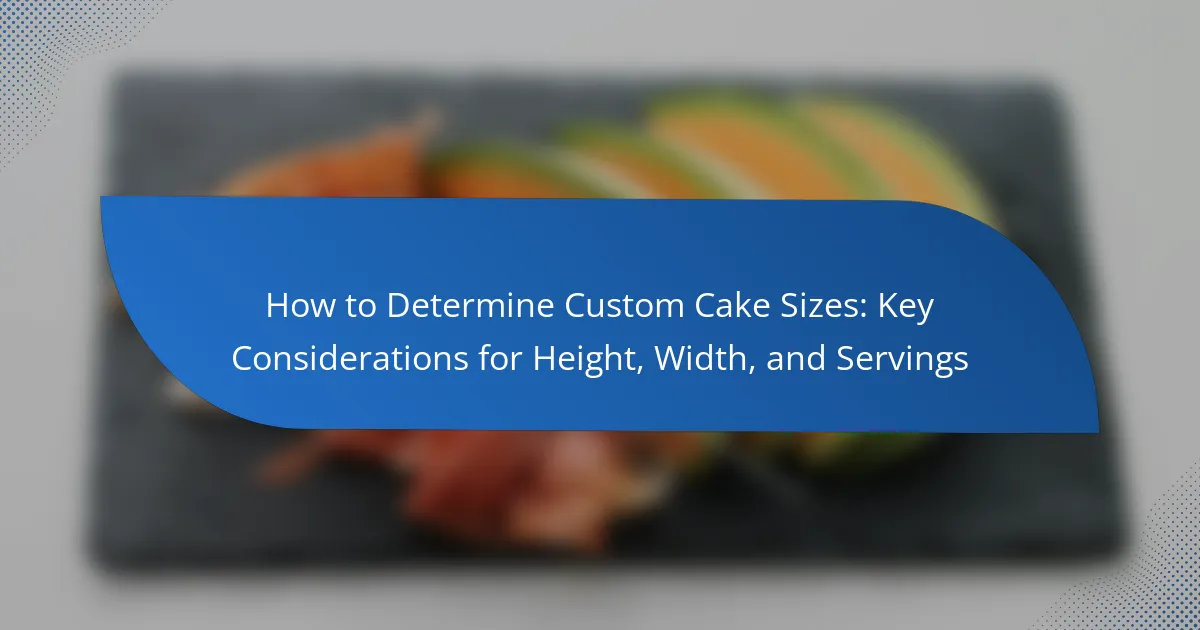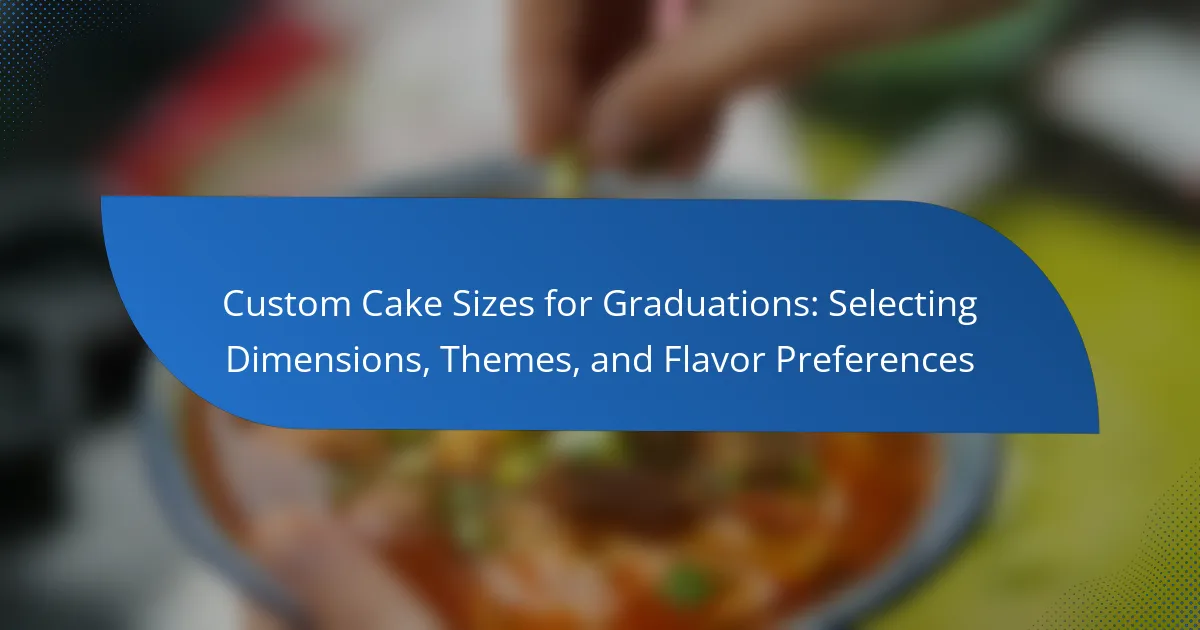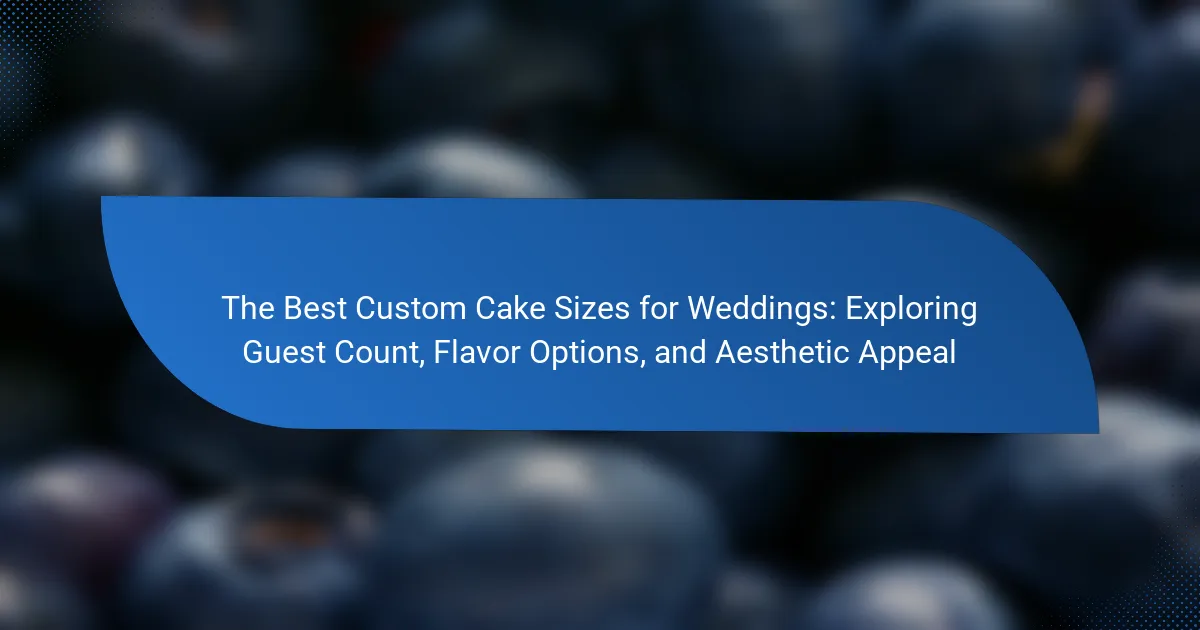Custom cake sizes are cakes specifically designed to meet individual requirements for dimensions and servings, varying based on occasions and guest numbers. Key factors influencing custom cake dimensions include design preferences, serving size requirements, and structural stability, which is essential for multi-tiered designs. Bakers often create cakes in unique shapes and heights to align with themes and personal specifications. Understanding standard sizes and consulting with a baker can help ensure that the cake meets both aesthetic and practical needs, accommodating the desired number of servings while maintaining visual appeal.
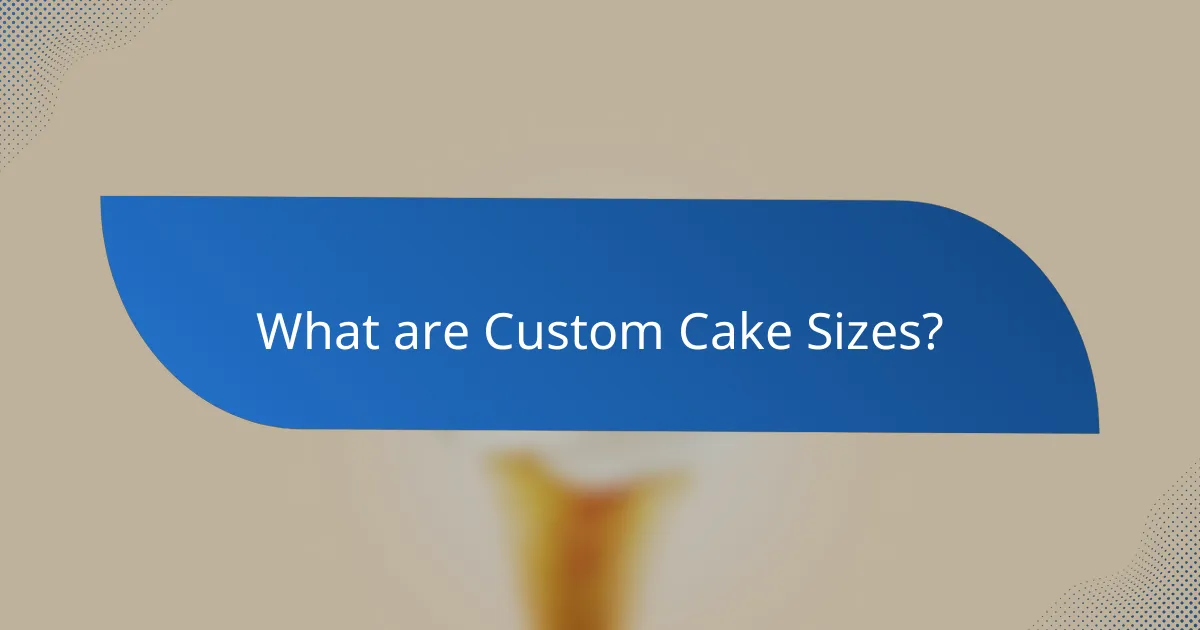
What are Custom Cake Sizes?
Custom cake sizes refer to cakes that are specifically designed to meet individual requirements for dimensions and servings. These sizes can vary widely based on the occasion and the number of guests. Bakers often create custom cakes in unique shapes, heights, and widths to fit themes or preferences. For example, a wedding cake may have multiple tiers, while a birthday cake might be a single layer. Custom sizes allow for flexibility in design and presentation. Many bakeries offer guidelines on standard sizes, but they also accommodate special requests. This adaptability ensures that cakes can be tailored to personal specifications.
How do custom cake sizes differ from standard sizes?
Custom cake sizes differ from standard sizes in their dimensions and flexibility. Standard cake sizes typically follow common measurements, such as 6, 8, or 10 inches in diameter. Custom cakes, however, can be tailored to specific requests, allowing for unique dimensions. This customization can include varying heights, widths, and even shapes.
Custom cakes may also accommodate specific serving requirements or design themes. For example, a custom cake can be made to fit a particular event space or guest count. This adaptability is not usually available with standard sizes.
Moreover, custom cakes often feature unique tier arrangements and designs. Standard cakes generally follow traditional tier structures. Customization allows for innovative designs that reflect personal preferences or themes.
The ability to create non-standard sizes is a key advantage of custom cakes. This ensures that the cake meets the exact needs of the occasion.
What factors contribute to the definition of custom cake sizes?
Custom cake sizes are defined by several factors including the number of servings required, the occasion, and design specifications. The number of servings dictates the overall volume and dimensions of the cake. For example, a wedding cake typically requires more servings than a birthday cake. The occasion influences the cake’s shape and size. A formal event may demand a larger, multi-tiered cake. Design specifications, such as height and width, also play a crucial role. Custom designs may require specific dimensions to accommodate decorations or structural elements. Additionally, baking pan sizes available can limit or define the final dimensions of the cake.
Why is it important to understand custom cake sizes?
Understanding custom cake sizes is crucial for ensuring that the cake meets the specific needs of an event. Custom sizes allow for precise servings based on guest counts. A well-sized cake can enhance presentation and overall satisfaction. Different occasions may require varying dimensions for visual impact. For instance, weddings often feature multi-tiered cakes that need careful sizing to maintain stability. Additionally, understanding sizes helps bakers manage ingredient quantities effectively. Accurate sizing can prevent waste and reduce costs. Knowing custom cake dimensions also aids in planning for transportation and storage. Overall, understanding these sizes ensures a successful cake experience tailored to the occasion.
What are the key attributes of custom cake sizes?
Key attributes of custom cake sizes include height, width, and tier count. Height refers to how tall the cake is, often impacting its visual appeal and serving size. Width indicates the diameter of the cake, affecting the overall volume and number of servings. Tier count denotes how many layers the cake has, which can enhance design and flavor variety. Customization allows for specific dimensions to cater to event requirements. These attributes are crucial for meeting client preferences and ensuring satisfaction.
How does height influence the overall appearance of a cake?
Height significantly influences the overall appearance of a cake. Taller cakes often appear more impressive and elegant. They can create a sense of grandeur for special occasions. Height allows for more decorative elements, such as tiers and intricate designs. A cake’s height can also affect its proportion to other elements on the table. For instance, a tall cake may stand out against lower decorations. Additionally, height can impact serving portions, as taller cakes typically yield more slices. In competitions, height is often a judging criterion, emphasizing its importance in cake aesthetics. Overall, height plays a crucial role in how a cake is perceived visually.
What role does width play in cake design and serving?
Width in cake design significantly affects both aesthetics and serving portions. A wider cake allows for more surface area, enhancing visual appeal through decoration. It also accommodates larger servings, making it suitable for events with many guests. For instance, a cake with a width of 12 inches can yield more slices than a 6-inch cake. This is crucial for planning and ensuring everyone is served. Additionally, width influences the stability of the cake, especially when layered. A wider base provides better support for taller tiers, reducing the risk of collapse. Overall, width plays a vital role in cake design and serving logistics.
How do tiers impact the structure and presentation of a cake?
Tiers significantly impact the structure and presentation of a cake. They provide height and visual interest, enhancing the overall aesthetic. A multi-tiered cake often appears more grand and celebratory. Each tier requires careful construction to ensure stability. Structural supports, like dowels, are essential for larger cakes to prevent collapsing. The arrangement of tiers can also influence flavor distribution. Different flavors can be layered in each tier, offering variety. Additionally, the design of each tier can be tailored to specific themes or events. This customization can include varying shapes, colors, and decorations, leading to a unique presentation.

What factors influence the height, width, and tiers of a custom cake?
The height, width, and tiers of a custom cake are influenced by design preferences, serving size requirements, and structural stability. Design preferences dictate the visual appeal and style of the cake. Serving size requirements determine how many guests the cake needs to accommodate. Structural stability ensures the cake can support its own weight, especially for multi-tiered designs. Additionally, the type of cake and frosting used can affect the overall dimensions. For example, denser cakes may require less height for stability.
How do event type and guest count affect cake dimensions?
Event type and guest count significantly influence cake dimensions. Different events require varying cake sizes based on the number of attendees. For example, weddings typically have larger guest counts, necessitating multi-tiered cakes. A standard wedding cake serves about 100 guests, requiring dimensions of approximately 6, 8, and 10 inches in diameter for each tier.
Conversely, smaller gatherings like birthday parties may only require a single-tier cake for 20 guests. This results in a smaller cake, often around 6 to 8 inches in diameter. Additionally, formal events may opt for more elaborate designs, increasing the height and complexity of the cake.
The relationship between guest count and cake size is supported by industry standards. Bakeries often use charts to determine the appropriate cake dimensions based on the number of servings needed. Thus, both the type of event and the number of guests directly dictate the size and structure of the cake.
What considerations should be made for weddings versus birthdays?
Weddings and birthdays require different considerations in cake design and size. Wedding cakes typically need to serve a larger number of guests, often ranging from 50 to over 200. They are usually multi-tiered, with elaborate designs and intricate decorations to reflect the couple’s theme. Birthday cakes can vary widely in size, serving anywhere from a small group to a larger gathering. They often feature simpler designs and can be customized with themes relevant to the birthday person.
For weddings, the cake’s height and tier count are often more significant due to tradition and presentation. In contrast, birthday cakes may focus more on flavor variety and personal themes. Weddings may also incorporate elements like cake cutting ceremonies, which influence the cake’s design. Birthday celebrations often prioritize fun and creativity, leading to diverse shapes and flavors.
These differences highlight the unique attributes of wedding and birthday cakes, affecting their design, size, and overall presentation.
How does the number of guests dictate cake size?
The number of guests directly determines the size of the cake needed. A general rule is to allocate one slice per guest. Standard cake slices typically measure around 2 inches by 2 inches. Therefore, if there are 20 guests, a cake should provide at least 20 slices. Cakes can be tiered or multi-layered to accommodate larger numbers. For example, a two-tier cake can serve more guests than a single-tier cake. Additionally, the cake’s width and height can be adjusted based on the guest count. Accurate sizing ensures everyone receives a slice, preventing shortages.
What design elements impact the size of a custom cake?
Design elements that impact the size of a custom cake include the number of tiers, the diameter of each tier, and the overall height. Tiers increase the cake’s size significantly, as each layer adds both height and width. The diameter of each tier determines the cake’s width and affects the overall volume. Additionally, decorative elements such as fondant or icing can add height without increasing the cake’s base size. The complexity of the design also influences the cake’s proportions, as elaborate designs may require larger dimensions for stability and aesthetics. Each of these factors plays a crucial role in determining the final size of a custom cake.
How do frosting and decorations affect cake height and width?
Frosting and decorations increase cake height and width. The thickness of frosting adds volume to the cake. A thicker layer of frosting can elevate the overall height significantly. Decorations, such as fondant or edible embellishments, also contribute to height. The width may be affected by the placement of decorations that extend beyond the cake’s edge. Additionally, certain decorations can create a visually wider appearance. For instance, large flowers or cascading elements can make the cake seem broader. Therefore, both frosting and decorations play a crucial role in determining cake dimensions.
What is the significance of cake flavor in determining size?
Cake flavor significantly influences the size of a cake. Different flavors often require varying ingredients and densities. For example, denser flavors like chocolate may support larger sizes without collapsing. Conversely, lighter flavors like sponge may necessitate smaller sizes to maintain structural integrity. Additionally, flavor preferences can dictate the number of tiers. Popular flavors may lead to larger cakes for more servings. Therefore, the choice of flavor directly impacts both the size and design of custom cakes.
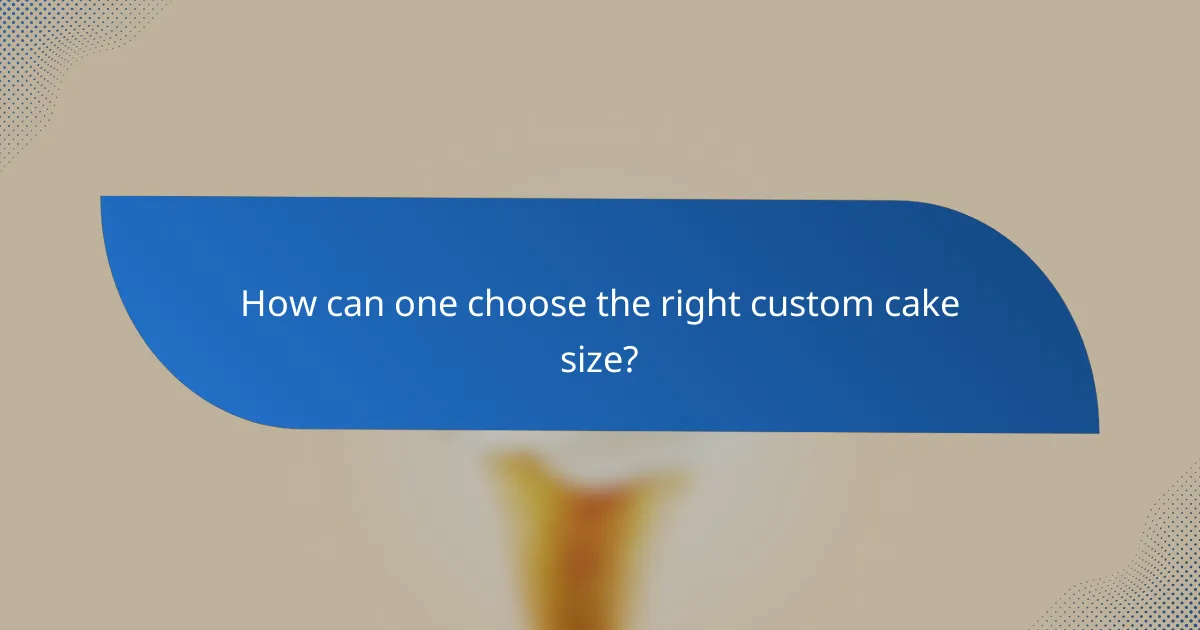
How can one choose the right custom cake size?
To choose the right custom cake size, consider the number of servings needed. Each guest typically consumes one slice of cake. Standard cake sizes vary; for example, an 8-inch round cake serves about 20 people. Additionally, consider the occasion; larger events require bigger cakes. The cake’s height and number of tiers also influence size. A three-tier cake can serve more guests than a single-layer cake of the same diameter. Finally, consult with a baker for guidance on portion sizes and design preferences. This ensures the cake meets both aesthetic and practical needs.
What tips should be considered when selecting cake dimensions?
When selecting cake dimensions, consider the number of servings needed. The size of the cake should match the guest count for adequate portions. Standard serving sizes for cakes are typically 1 inch by 2 inches. Additionally, think about the occasion and its formality. A more formal event may require a tiered cake for visual appeal.
Next, account for the cake’s design and decoration. Intricate designs may necessitate larger dimensions to showcase details effectively. Also, consider the height of the cake. Taller cakes can create an impressive look but may require additional support.
Lastly, factor in transportation and storage. Ensure the selected dimensions fit within your vehicle and available space. Selecting appropriate cake dimensions enhances both aesthetics and practicality for your event.
How can you balance aesthetics with practicality in cake size selection?
To balance aesthetics with practicality in cake size selection, consider guest count and design. The cake size should accommodate the number of guests while allowing for decorative elements. A common guideline is to allocate one slice per guest. This ensures everyone is served without excess waste.
For aesthetics, tiered cakes can enhance visual appeal. Each tier can be designed uniquely while maintaining proportion. However, larger cakes may require more support and stability. This aspect is crucial for practical serving.
Additionally, consider the venue space. A large cake may overwhelm a small table. Conversely, a small cake may look lost in a grand setting. Balancing these factors leads to a visually appealing and practical cake choice.
What common mistakes should be avoided when choosing a custom cake size?
One common mistake when choosing a custom cake size is underestimating guest count. This can lead to insufficient servings for everyone. Another mistake is not considering the cake’s height and width. A tall cake may look impressive but can be unstable. Failing to account for the venue space is also crucial. A large cake may not fit in smaller venues. Additionally, neglecting to discuss size with the baker can result in miscommunication. Bakers can provide valuable insights into portion sizes. Lastly, overlooking the cake’s design can affect size choices. Intricate designs may require more cake to support them.
What resources are available for determining custom cake sizes?
Resources for determining custom cake sizes include online calculators, baking books, and professional cake design websites. Online calculators allow users to input guest numbers and desired servings to calculate dimensions. Baking books often provide charts for standard cake sizes and serving suggestions. Professional cake design websites offer guidelines and tips based on industry standards. These resources help bakers create cakes that meet specific needs.
Where can you find tools or calculators for cake sizing?
You can find tools or calculators for cake sizing on various baking websites and apps. Websites like Wilton, CakeCentral, and MyCakeSchool offer interactive calculators. These tools help determine the sizes and servings needed for custom cakes. Many of these resources are free and user-friendly. They provide specific measurements based on the number of servings you require. Additionally, some baking apps available on mobile platforms include cake sizing calculators. These tools are designed for both novice and experienced bakers. They ensure accurate measurements for successful cake designs.
How can professional bakers assist in selecting the right cake size?
Professional bakers can assist in selecting the right cake size by evaluating the number of guests and the occasion. They often use standard serving sizes to determine the appropriate dimensions. For example, a standard slice is typically 1 inch by 2 inches. Bakers can also provide guidance on tiered cakes, which can serve more people while maintaining an elegant appearance. Additionally, they consider the cake’s height and width to match the event’s theme. By discussing preferences and requirements with clients, bakers ensure that the final cake meets expectations. Their experience allows them to recommend sizes that balance aesthetics and practicality.
What are best practices for ordering custom cakes?
To order custom cakes effectively, begin by clearly defining your requirements. Specify the cake size, flavor, and design to ensure accuracy. Provide the baker with any relevant themes or colors. Communicate dietary restrictions or allergies, if applicable. Place your order well in advance to allow for proper preparation time. Discuss delivery or pickup options to avoid last-minute issues. Review and confirm all details before finalizing the order. Following these practices helps ensure a satisfactory cake experience.
Custom cake sizes are specifically tailored cakes designed to meet individual requirements for dimensions and servings, varying widely based on the occasion and number of guests. This article explores how custom sizes differ from standard sizes, highlighting key attributes such as height, width, and tier count, which influence the cake’s design and serving capacity. Factors like event type, guest count, and design specifications play crucial roles in determining the appropriate size, ensuring that cakes are both visually appealing and practical for their intended use. Additionally, the article provides best practices for selecting and ordering custom cakes, emphasizing the importance of communication with bakers to achieve desired outcomes.
